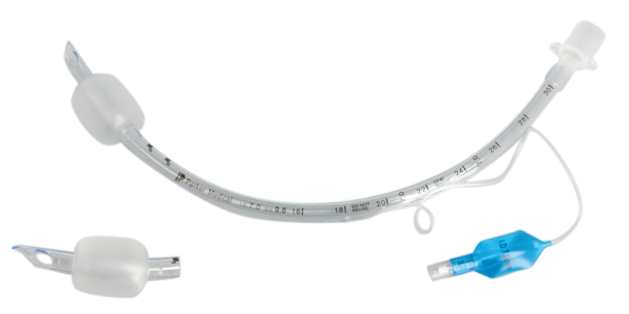
Parker Flex-tip Endotracheal Tube, Cuffed
Item. No.: NMR1001
The Parker Flex tip endotracheal tube is a cuffed tube that is inserted into the trachea for airway management and to provide a route for mechanical ventilation. The tube has a reinforced proximal end to minimize kinking and an atraumatic, rounded distal tip to minimize trauma to the tracheal mucosa. The Parker Flex tip endotracheal tube is available in sizes from 3.0 mm ID to 10.0 mm ID.
The Parker Flex tip endotracheal tube is a cuffed tube that is inserted into the trachea for airway management and to provide a route for mechanical ventilation. The tube has a reinforced proximal end to minimize kinking and an atraumatic, rounded distal tip to minimize trauma to the tracheal mucosa. The Parker Flex tip endotracheal tube is available in sizes from 3.0 mm ID to 10.0 mm ID.
The Parker Flex tip Endotracheal Tube is a type of tube that is inserted into the trachea (windpipe) to help with breathing. This tube has a small, flexible tip that makes it easier to insert and remove. The Parker Flex tip Endotracheal Tube is also cuffed, which means that there is a balloon-like cuff around the tube that helps to keep it in place.
The Parker Flex tip Endotracheal Tube is a tube that is inserted through the mouth or nose and goes down the trachea (windpipe). This type of tube is often used during surgery to help the patient breathe. The tube has a small balloon at the end, which is inflated once the tube is in place. This helps to keep the tube from moving around and falling out.
The Parker Flex tip endotracheal tube is a great option for those who need a cuffed tube. This type of tube has many benefits, including:
1. The Parker Flex tip provides a better seal around the trachea, which helps to prevent leakage and aspiration.
2. The cuffed design helps to keep the tube in place and provides additional protection against leakage.
3. The Parker Flex tip is made from a softer material, which is more comfortable for the patient.
4. The unique design of the Parker Flex tip allows for easy removal of the tube when necessary.
No, there are no risks associated with the Parker Flex tip Endotracheal Tube. It is a safe and effective way to provide oxygen to patients who are unable to breathe on their own.
The Parker Flex tip endotracheal tube is a unique type of tube that offers many benefits over other types of tubes. One benefit is that it is easier to insert and remove. This can be a big advantage for patients who need to have the tube inserted and removed frequently. Another advantage is that the Parker Flex tip provides better ventilation. This can be helpful for patients who are having difficulty breathing. Finally, the Parker Flex tip is less likely to cause irritation to the airway. This can be helpful for patients who are particularly sensitive to airway irritation.